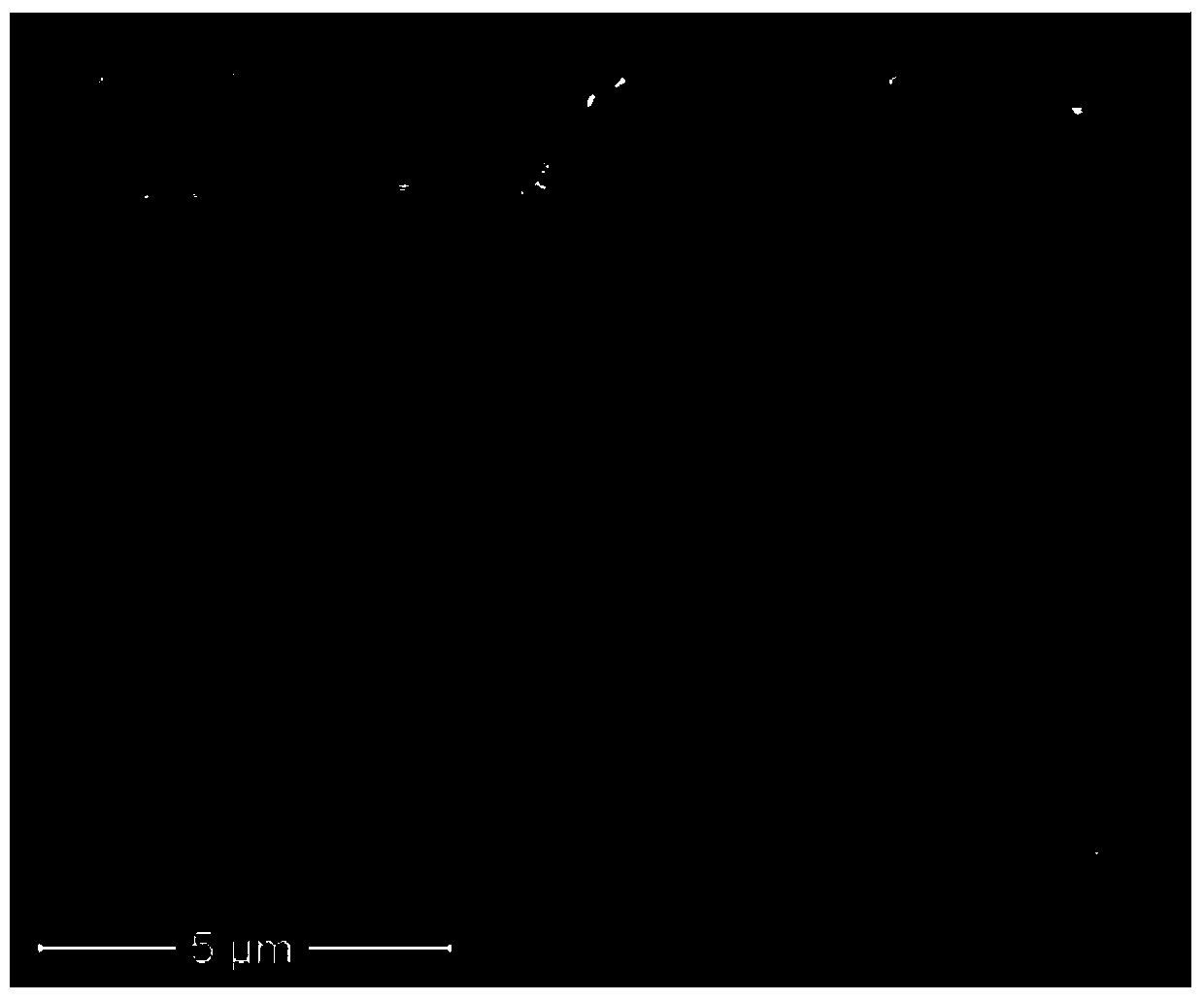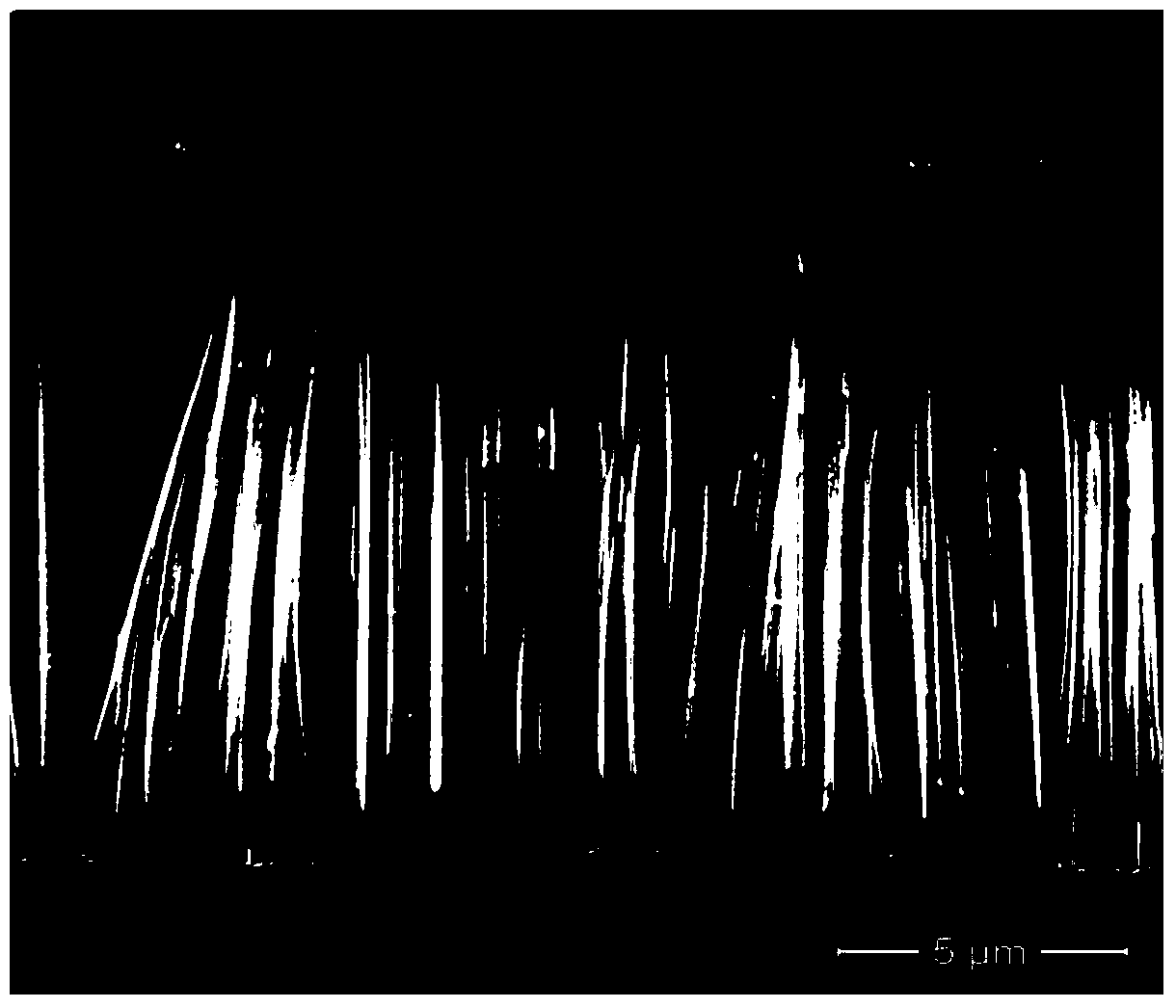Pt/silicon nanometer array structure composite material and preparation method thereof
A technology of silicon nanoarray and composite material, applied in the field of Pt/silicon nanoarray structure composite material and its preparation, can solve the problems of secondary chemical damage, increase of surface defects, unfavorable photoelectric energy conversion, etc., and achieve effective absorption and conversion, Effect of reducing recombination centers, good visible light absorption
- Summary
- Abstract
- Description
- Claims
- Application Information
AI Technical Summary
Problems solved by technology
Method used
Image
Examples
Embodiment 1
[0042] 1. Preparation of silicon nanowire arrays:
[0043] Cut the p-type Si wafer into 1 × 2 cm 2 The squares were ultrasonically washed with deionized water, absolute ethanol and acetone, and then immersed in H 2 SO 4 and H 2 o 2 Take out after 10 minutes in the mixed solution (mixed solution by H 2 SO 4 (98%) and H 2 o 2 (35%) configured according to the volume ratio of 3:1). The silicon wafer was placed in a 5% HF aqueous solution, allowed to stand for 1 minute, and then taken out. The silicon wafer was rapidly transferred to a solution containing 4.8M HF and 5mM AgNO 3 In the mixed solution, stir slowly, and take it out after 60 seconds of reaction. Then transfer the silicon wafer to 4.8M HF and 0.25mM H 2 o 2 In the solution, react for 45 minutes under the condition of avoiding light, and obtain the silicon nanowire array. Next, the silicon nanowire arrays were transferred into nitric acid solution (V HNO3(63%) :V 水 =1:1) for 3 hours, remove Ag ions, and t...
Embodiment 2
[0048] 1. Preparation of porous silicon nanoarray structure:
[0049] Cut the p-type Si wafer into 1 × 2 cm 2 The squares were ultrasonically washed with deionized water, absolute ethanol and acetone, and then immersed in H 2 SO 4 and H 2 o 2 Take out after 10 minutes in the mixed solution (mixed solution by H 2 SO 4 (98%) and H 2 o 2 (35%) configured according to the volume ratio of 3:1). The silicon wafer was placed in a 5% HF aqueous solution, allowed to stand for 1 minute, and then taken out. The silicon wafer was rapidly transferred to a solution containing 4.8M HF and 5mM AgNO 3 In the mixed solution, stir slowly, and take it out after 60 seconds of reaction. Then transfer the silicon wafer to 4.8M HF and 0.25mM H 2 o 2 In the solution, react for 10 minutes under the condition of avoiding light, and obtain the porous silicon nano-array. Next, the porous silicon nanoarrays were transferred into nitric acid solution (V HNO3(63%) :V 水 =1:1) for 3 hours, remov...
Embodiment 3
[0053] 1. Preparation of silicon nanowire arrays:
[0054] Cut the n-type Si wafer into 1 × 2 cm 2 The squares were ultrasonically washed with deionized water, absolute ethanol and acetone, and then immersed in H 2 SO 4 and H 2 o 2 Take out after 10 minutes in the mixed solution (mixed solution by H 2 SO 4 (98%) and H 2 o 2 (35%) configured according to the volume ratio of 3:1). The silicon wafer was placed in a 5% HF aqueous solution, allowed to stand for 1 minute, and then taken out. The silicon wafer was rapidly transferred to a solution containing 4.8M HF and 5mM AgNO 3 In the mixed solution, stir slowly, and take it out after 60 seconds of reaction. Then transfer the silicon wafer to 4.8M HF and 0.25mM H 2 o 2 In the solution, react for 45 minutes under the condition of avoiding light, and obtain the silicon nanowire array. Next, the silicon nanowire arrays were transferred into nitric acid solution (V HNO3(63%) :V 水 =1:1) for 3 hours, remove Ag ions, and t...
PUM
| Property | Measurement | Unit |
|---|---|---|
| diameter | aaaaa | aaaaa |
| diameter | aaaaa | aaaaa |
| concentration | aaaaa | aaaaa |
Abstract
Description
Claims
Application Information
 Login to View More
Login to View More - R&D
- Intellectual Property
- Life Sciences
- Materials
- Tech Scout
- Unparalleled Data Quality
- Higher Quality Content
- 60% Fewer Hallucinations
Browse by: Latest US Patents, China's latest patents, Technical Efficacy Thesaurus, Application Domain, Technology Topic, Popular Technical Reports.
© 2025 PatSnap. All rights reserved.Legal|Privacy policy|Modern Slavery Act Transparency Statement|Sitemap|About US| Contact US: help@patsnap.com



